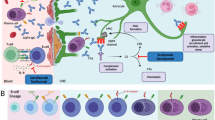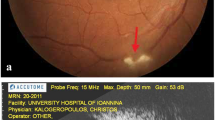Abstract
Purpose
We aim to report on the clinical, imaging, immunological, and electrophysiological features of patients with autoimmune retinopathy (AIR) with long-term follow-up.
Methods
Single-center, retrospective study of a consecutive group of AIR patients treated in a tertiary academic medical center.
Results
Included were nine patients with a mean ± SD age at presentation of 65 ± 13 years and a median follow-up of 63 months (range 18–120). Five patients were known to have cancer. Median interval between onset of ocular symptoms and diagnosis of AIR was 36 months. Mean baseline and final LogMAR visual acuity were 0.72 ± 0.9 and 1.1 ± 1.2, respectively (p = 0.17). The most common funduscopic findings included optic atrophy and bone-spicule-like pigmentation. Thinning of the nerve fiber layer was the most frequent optical coherence tomographic abnormality. Electroretinographic (ERG) recordings demonstrated variably reduced cone- and rod-derived amplitudes in the majority of eyes at presentation. The most commonly detected anti-retinal antibody was anti-α-enolase. Treatment included immunomodulatory therapy and plasmapheresis. ERG tests showed stability in 64% of eyes throughout the treatment period.
Conclusion
This study highlights the importance of maintaining a high index of suspicion of AIR, particularly in late middle-aged and elderly patients with “unexplained” visual loss, in light of the non-specific posterior segment signs and the inconsistency of the routinely used ancillary tests.










Similar content being viewed by others
Data availability
The corresponding author has full access to all the data in the study and takes responsibility for the integrity of the data and the accuracy of the data analysis as well as the decision to submit for publication.
All procedures performed in studies involving human participants were in accordance with the ethical standards of the institutional (HMO-Hadassah Medical Organization IRB approved the study) and/or national research committee and with the 1964 Helsinki Declaration and its later amendments or comparable ethical standards.
References
Adamus G, Ren G, Weleber RG (2004) Autoantibodies against retinal proteins in paraneoplastic and autoimmune retinopathy. BMC Ophthalmol 4:1–9. https://doi.org/10.1186/1471-2415-4-5
Adamus G (2003) Autoantibody-induced apoptosis as a possible mechanism of autoimmune retinopathy. Autoimmun Rev 2:63–68
Adamus G, Champaigne R, Yang S (2020) Occurrence of major anti-retinal autoantibodies associated with paraneoplastic autoimmune retinopathy. Clin Immunol 210.https://doi.org/10.1016/j.clim.2019.108317
Heckenlively JR, Ferreyra HA (2008) Autoimmune retinopathy: a review and summary. Semin Immunopathol 30:127–134
Grange L, Dalal M, Nussenblatt RB, Sen HN (2014) Autoimmune retinopathy. Am J Ophthalmol 157:266. https://doi.org/10.1016/j.ajo.2013.09.019
Ferreyra HA, Jayasundera T, Khan NW et al (2009) Management of autoimmune retinopathies with immunosuppression. Arch Ophthalmol 127:390–397. https://doi.org/10.1001/archophthalmol.2009.24
Jacobson DM, Thirkill CE, Tipping SJ (1990) A clinical triad to diagnose paraneoplastic retinopathy. Ann Neurol 28:162–167. https://doi.org/10.1002/ana.410280208
Weleber RG, Watzke RC, Shults WT et al (2005) Clinical and electrophysiologic characterization of paraneoplastic and autoimmune retinopathies associated with antienolase antibodies. Am J Ophthalmol 139:780–794. https://doi.org/10.1016/j.ajo.2004.12.104
Chan JW (2003) Paraneoplastic retinopathies and optic neuropathies. Surv Ophthalmol 48:12–38
Ohguro H, Yokoi Y, Ohguro I et al (2004) Clinical and immunologic aspects of cancer-associated retinopathy. Am J Ophthalmol 137:1117–1119. https://doi.org/10.1016/j.ajo.2004.01.010
Finn AP, Thomas AS, Stinnett SS et al (2018) The role of cystoid macular edema as a marker in the progression of non-paraneoplastic autoimmune retinopathy. Graefe’s Arch Clin Exp Ophthalmol 256:1867–1873. https://doi.org/10.1007/s00417-018-4084-8
Abazari A, Allam SS, Adamus G, Ghazi NG (2012) Optical coherence tomography findings in autoimmune retinopathy. Am J Ophthalmol 153.https://doi.org/10.1016/j.ajo.2011.09.012
Pepple KL, Cusick M, Jaffe GJ, Mruthyunjaya P (2013) SD-OCT and autofluorescence characteristics of autoimmune retinopathy. Br J Ophthalmol 97:139–144
Tsang SH, Sharma T (2018) Autoimmune retinopathy. Advances in Experimental Medicine and Biology. Springer, New York LLC, pp 223–226
Masaoka N, Emoto Y, Sasaoka A et al (1999) Fluorescein angiographic findings in a case of cancer-associated retinopathy. Retina 19:462–464. https://doi.org/10.1097/00006982-199919050-00022
Rahimy E, Sarraf D (2013) Paraneoplastic and non-paraneoplastic retinopathy and optic neuropathy: Evaluation and management. Surv Ophthalmol 58:430–458
Sawyer RA, Selhorst JB, Zimmerman LE, Hoyt WF (1976) Blindness caused by photoreceptor degeneration as a remote effect of cancer. Am J Ophthalmol 81:606–613. https://doi.org/10.1016/0002-9394(76)90125-2
Murphy MA, Thirkill CE, Hart WM (1997) Paraneoplastic retinopathy: a novel autoantibody reaction associated with small-cell lung carcinoma. J Neuroophthalmol 17:77–83
Guy J, Aptsiauri N (1999) Treatment of paraneoplastic visual loss with intravenous immunoglobulin: Report of 3 cases. Arch Ophthalmol 117:471–477. https://doi.org/10.1001/archopht.117.4.471
Maleki A, Lamba N, Ma L et al (2017) Rituximab as a monotherapy or in combination therapy for the treatment of non-paraneoplastic autoimmune retinopathy. Clin Ophthalmol 11:377–385. https://doi.org/10.2147/OPTH.S120162
Shildkrot Y, Sobrin L, Gragoudas ES (2011) Cancer-associated retinopathy: Update on pathogenesis and therapy. Semin Ophthalmol 26:321–328
Jabs DA, Nussenblatt RB, Rosenbaum JT et al (2005) Standardization of uveitis nomenclature for reporting clinical data. Results of the First International Workshop. Am J Ophthalmol 140:509–516
McCulloch DL, Marmor MF, Brigell MG et al (2015) ISCEV Standard for full-field clinical electroretinography (2015 update). Doc Ophthalmol 130:1–12
Igarashi N, Sawamura H, Kaburaki T, Aihara M (2019) Cancer-associated retinopathy developing after 10 years of complete breast cancer remission. Neuro-Ophthalmology 43:36–42. https://doi.org/10.1080/01658107.2018.1460761
Makiyama Y, Kikuchi T, Otani A et al (2013) Clinical and immunological characterization of paraneoplastic retinopathy. Investig Ophthalmol Vis Sci 54:5424–5431. https://doi.org/10.1167/iovs.13-11868
Adamus G, Aptsiauri N, Guy J et al (1996) The occurrence of serum autoantibodies against enolase in cancer-associated retinopathy. Clin Immunol Immunopathol 78:120–129. https://doi.org/10.1006/clin.1996.0021
Gitlits VM, Toh BH, Sentry JW (2001) Disease association, origin, and clinical relevance of autoantibodies to the glycolytic enzyme enolase. J Investig Med 49:138–145
Pancholi V (2001) Multifunctional α-enolase: Its role in diseases. Cell Mol Life Sci 58:902–920
Adamus G, Karren L (2009) Autoimmunity against carbonic anhydrase II affects retinal cell functions in autoimmune retinopathy. J Autoimmun 32:133–139. https://doi.org/10.1016/j.jaut.2009.02.001
Adamus G, Yang S, Weleber RG (2016) Unique epitopes for carbonic anhydrase II autoantibodies related to autoimmune retinopathy and cancer-associated retinopathy. Exp Eye Res 147:161–168. https://doi.org/10.1016/j.exer.2016.05.012
Mantel I, Ramchand KV, Holder GE et al (2008) Macular and retinal dysfunction of unknown origin in adults with normal fundi: Evidence for an autoimmune pathophysiology. Exp Mol Pathol 84:90–101. https://doi.org/10.1016/j.yexmp.2007.10.006
Author information
Authors and Affiliations
Contributions
KS was involved in the design and conduct of the study, collection and analyzing of the data, and writing the manuscript. RA was involved in the management of the clinical cases, the design and conduct of the study, and writing the manuscript. IC, EB, BR, and LT were involved in analyzing the ERG tests and reviewing the manuscript.
Corresponding author
Ethics declarations
Informed consent
This type of study does not require an informed consent.
Conflict of interest
The authors declare no competing interests.
Additional information
Publisher’s note
Springer Nature remains neutral with regard to jurisdictional claims in published maps and institutional affiliations.
Rights and permissions
About this article
Cite this article
Safadi, K., Chowers, I., Banin, E. et al. Autoimmune retinopathy: clinical, electrophysiological, and immunological features in nine patients with long-term follow-up. Graefes Arch Clin Exp Ophthalmol 260, 975–991 (2022). https://doi.org/10.1007/s00417-021-05409-4
Received:
Revised:
Accepted:
Published:
Issue Date:
DOI: https://doi.org/10.1007/s00417-021-05409-4




